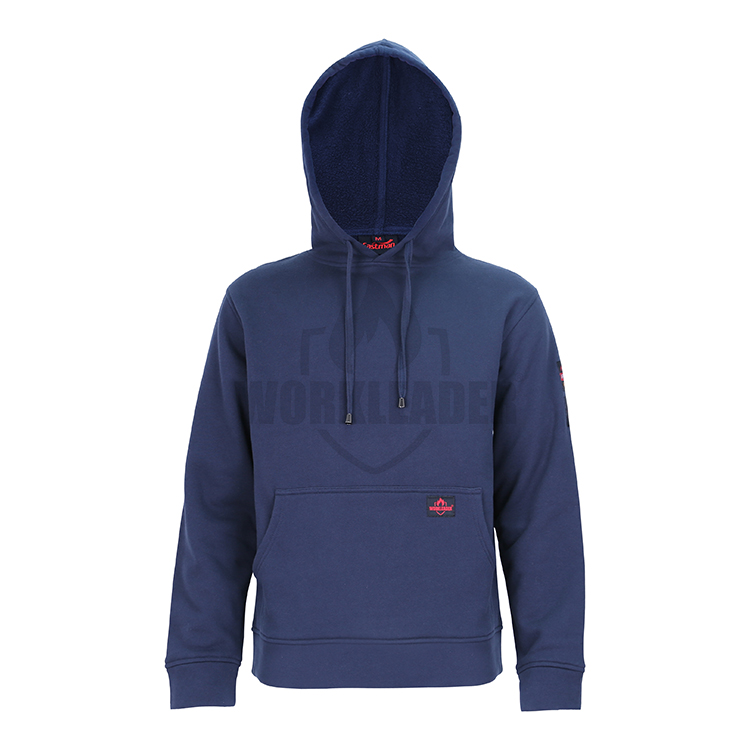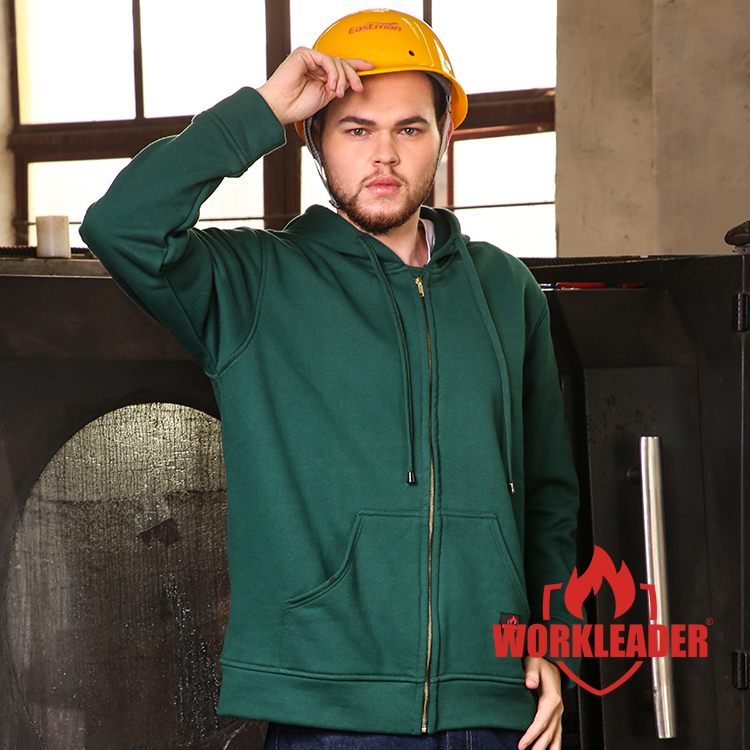Categories
Product Recommended

Flame Resistant Fleece Hoodie Suit

Knit 100% Catton Fire Retardant Hood

Flame Retardant Hoodies For Worker
FR Clothing
What Is Fr Clothing
Flame resistant clothing is any wearable item made from a fabric woven from fibers that will naturally stop or extinguish flames should it be exposed to fire or sparks. In some industries, it is not only recommended but required for safety. In some instances, this clothing can stop severe injury or death from occurring on the job. Clothing that is flame resistant is generally also designed so that it doesn't break open when heated.
Benefits Of FR Clothing
- Protection from fire
- Fire resistant clothes protect people from burns caused by fire or sparks working in hazardous workplaces like oil and gas factories, welding factories, and dangerous workplaces. Wearing Fr-rated clothes may reduce the risk of severe injuries and save workers' lives.
- Increases safety
- Workers wearing fire resistant clothes in factories can work safely in high risk environments. This can help prevent accidents and minimize the risk of injuries on the job.
- Compliance with safety regulations
- Many industries are now adapting safety workwear for workers to wear fire resistant clothes during work to prevent accidents. Employers can ensure compliance with these regulations by providing workers with FR clothing and avoiding potential fines or legal issues.
- Durable and long-lasting
- Fire resistant (FR) clothing is typically made from high-quality materials designed to withstand wear and tear and keep fashion in mind to give both comfort and protection even in a harsh environment.
Why Choose Us
-
01/
Professional team and equipmentWith more than 30 years of production experience, we have a mature team and equipment. From fabrics to garments, we use smart machines. We are efficient and cost-effective.
-
02/
MarketOur garments have been exported to many countries and regions in the world, such as Europe, North America, South America, Middle East, etc. We export 150 X 40 FCL every year.
-
03/
Provide the best quality productsWe provide the highest quality fibers, fabrics and finishes to create the most comfortable, durable and ultimate protective PPE and FR clothing.
-
04/
Our serviceYour satisfaction is always our top priority. If you need real-time assistance, please feel free to contact us through our customer service hotline 0371-86173598.
How FR Clothing Is Rated?
FR clothing is categorized using an arc rating, or an Arc Thermal Protective Value (ATPV). This rating indicates how much heat will be transferred through the fabric in the event of an arc flash, and therefore, how much protection the clothing will offer the wearer. The values used to determine arc ratings are expressed as calories per square centimeter. The higher the arc rating, the more protection the piece of clothing will provide. An arc rating of 4 is suitable for a task assessed as a Hazard/Risk Category 1 (HRC1), the lowest risk, while an arc rating of 40 or more will protect the wearer when carrying out tasks assessed as Hazard/Risk Category 4 (HRC4), the most severe risk.
How Does FR Clothing Work?

- FR clothing works by inhibiting the conduction of heat and electricity through the fabric, which reduces the likelihood of the clothing catching fire. If the clothing does ignite, its design restricts the burn to the specific area exposed to heat or flames, preventing the fire from spreading to the entire garment or causing it to melt onto the wearer's skin. This feature helps minimize the risk of severe injuries. It also maintains its integrity and protects for as long as possible until the flame can be extinguished.
What Conditions Beckon Use Of FR Clothing?

- 1. The employee is exposed to contact with energized circuit parts operating at more than 600 volts.
2. An electric arc could ignite flammable material in the work area that, in turn, could ignite the employee's clothing.
3. Molten metal or electric arcs from faulted conductors in the work area could ignite the employee's clothing.
4. The incident heat energy estimate exceeds 2.0 cal/cm2 (p. 390).
How to Choose The Right FR Clothing
Level of protection
Depending on the work being performed by employees while wearing the garment, different levels of protection are recommended. Manufacturers of flame-resistant clothing will list the hazard risk category on the item to ensure that the item chosen offers the right level of protection.
Comfort
Comfort is a big concern when choosing flame-resistant clothing, especially if it must be worn all day, in very hot or very cold temperatures, or when doing extreme manual labor. If the garment protects against burns but causes chafing, overheats the wearer, or is so bulky that it gets in the way of completing required tasks, it's not going to be an effective choice. Comfortable employees are not only going to be more productive, but they'll be more likely to wear their protective gear and be happier on the job.
Maintenance
It is important to clean flame-resistant clothing according to the manufacturer's directions so it maintains its flame-resistant properties and continues to protect the wearer. Some manufacturers have very strict guidelines for care and cleaning that will be costly for the employer or so costly for the employee that they may not be able to reasonably meet those expectations, especially if they need to wear the item daily.
Compliance with standards
Ensure your FR clothing meets key standards such as NFPA 2112 and NFPA 2113. These standards guide the design and manufacture of flame-resistant clothing and help consumers make informed decisions.
Types Of FR Clothing
FR shirts and pants
These work clothes are made of flame-resistant material and are designed for daily wear at job sites with a risk of flash fires or electric arcs.
FR coveralls
These one-piece suits provide full-body protection and are commonly used in oil, gas, and chemical industries.
FR jackets and coats
These are worn in colder environments or situations where additional protection is needed.
FR lab coats and aprons
Used in laboratories or food service areas, these garments provide protection in workplaces where a small fire could break out suddenly.
FR boots
Essential for many industrial jobs, some boots are designed to provide foot protection against flame and heat hazards. They often have other safety features, such as slip-resistant soles, electrical hazard protection, and toe protection. Many wildland fire boots comply with or are certified by the National Fire Protection Association (NFPA) for flame resistance.
FR accessories (belts, hoods, etc.)
Even accessories can be flame-resistant. FR belts, for example, are made from materials that resist ignition and can help prevent injuries. Similarly, FR hoods provide added protection for the head and neck area, which can be critical in specific high-risk environments.
Material of FR Clothing
Acrylic, Polyester and/or Nylon: While not ideal for base layer fire protection, these three fabrics can offer fire resistance when blended with wool, silk, or other manmade fabrics.
Kevlar: Similar to Nomex, Kevlar is manmade and uses a chain or polyamide chemicals to create a fire-resistant and strong fabric.
Modacrylic: This synthetic fiber is soft, light, resilient, and fire resistant. Additionally, this fabric is easy to weave into almost any clothing.
Nomex: This manmade fiber uses a chain or polyamide chemicals to create a fabric that is both fire resistant and strong enough for most work environments.
Silk: Some FR clothing use silk in a blend of fabrics. Silk burns slowly and is difficult to ignite. However, silk is not used as extensively for base-layer FR workwear as it can melt under high temperatures.
Viscose fiber: Also known as viscose-T100, this manmade fiber uses phosphorous and a blend of other fabrics. Similar to wool, viscose keeps the wearer comfortable in both cold and warm weather.
Wool: The most common and natural of all fibers used for fire-resistant clothing is generally made from wool or a blend of wool and other fabrics. Because wool is difficult to ignite, extinguishes itself quickly, and it keeps the wearer warm in the winter and cool in the summer.
Application Of FR Clothing
The oil and gas industry
Flash fires, explosions, and toxic chemical exposure are prevalent dangers in the presence of oil and gas. Even the smallest mishap or sudden spark could result in a dangerous fire or electric arc. For this reason, workers in the oil and gas industry must protect themselves with FR clothing during shifts to do their jobs to the best of their abilities.
Electric utility or electricians
When on the job, those working on electric utility lines or circuits face a consistent threat to safety due to their work equipment and environmental conditions. Potential hazards include interaction with high voltages alongside assorted welding and cutting risks. A sudden electrical arc flash has the power to cause electrocution and high-temperature burns. As follows, utility line workers and traditional electricians need FR clothing to serve as the best possible protective barrier.
Chemical and pharmaceutical plants
Jobs at chemical-based plants are undoubtedly part of the modern industries that require fire-resistant clothing. Due to the materials they work with and the wide array of chemicals surrounding them daily, these workers face a special breed of danger. Risks include chemical spills, splashes, or possible flash fires or explosions resulting from chemical chain reactions, flammable gases, or pressurized liquids.
Pulp and paper processing
Workers in the pulp and paper industry need proper protection from a wide range of risky scenarios because every step in the paper-making process exposes workers to dangerous equipment and material use. This high-risk job at an industrial warehouse involves highly-flammable wood and paper that could cause flash fires or explosions. Workers can significantly reduce their risk of severe harm or danger by wearing FR clothing.
Metal smelting and welding
Working with metals daily in a welding shop or foundry can be an unpredictable job. No other industry has the same potential level of danger due to frequent high-temperature use, the presence of molten metal, and an array of fire causing scenarios. Employees in metal-based industries must follow safety procedures and wear the right FR protective gear when smelting, cutting, casting, or welding.
Maintenance Tips For FR Clothing
Laundry best practices
Always follow the manufacturer's washing instructions. Use regular laundry detergent and warm water, avoiding chlorine bleach to preserve the flame resistant properties. After washing, tumble dry on a low setting and avoid over-drying to prevent damage to the fibers.
Stain removal
For tough stains, pre-treat your FR clothing by soaking it in a liquid detergent or a non-bleach, non-peroxide pre-wash stain remover. This helps to break down the stains without compromising the garment's protective features.
Storage and inspection
Store your FR clothing in a secure location away from pests and moisture. Before each use, conduct a thorough inspection to check for any signs of wear such as thin or torn fabric, non-functioning elements, or stains that could affect the clothing's performance.
Damage prevention
Be vigilant around sharp objects or equipment that could potentially damage the FR clothing. If you notice significant damage either repair the garments with the same flame resistant fabric or remove the items from service immediately.
Laundering separately
Wash your FR clothing separately from other garments and turn them inside out to help with color retention and to preserve the garment's appearance.
Common Mistakes to Avoid When Wearing FR Clothing
Outer layer clothing is NOT fr
Even though your inner clothing may be flame-resistant, non-flame-resistant outer clothing can still ignite and burn, thus putting you in danger. Thus, it's important to invest in flame-resistant outer clothing for colder months, such as FR parka jackets. Such type of clothing is worth buying because it provides required protection both from cold weather and burns.
Inner layer clothing is not fr
It's important to ensure that you wear FR clothing for your undershirts or nothing at all. Even if you're wearing a flame-resistant outer layer of workwear, non-flame-resistant underclothes can still catch fire. This can expose you to burns since garments of polyester or other synthetic materials can quickly ignite and burn when in contact with fire. These materials can also melt onto your skin.
Rolling up your sleeves
Rolling up your sleeves will expose your hands and arms to flash fires, welding splatters, or other potential dangers. To remain comfortable while also ensuring your safety, make sure to wear flame-resistant clothing that is lightweight and moisture-wicking.
Leaving your fr clothing unbuttoned or unzipped
Just as you should avoid rolling up your sleeves, you should also avoid leaving your flame-resistant clothing unbuttoned or unzipped. Leaving your PPE unbuttoned or unzipped is like placing your safety glasses on top of your head and not wearing it properly to protect your eyes. It can expose your skin to life-threatening hazards. Always ensure that you wear your flame-resistant clothing and other PPE properly.
Leaving your shirt untucked
Always make sure that your inner shirts are tucked in. Heat and flame can go through it and that may result in serious injury. Consider buying flame-resistant clothing designed to have long shirttails that you can tuck into your pants.
FAQ
-
A: It is best to line dry an FR clothing or tumble-dry on low to minimize shrinkage. Remove the garment from the dryer while it is still damp. For heavily soiled garments, wash in the hottest temperature allowed on the care label (generally warm setting) to remove dirt. FR clothing can be dry-cleaned any time.
-
A: No, you should not use bleach when laundering FR clothing. There is data to suggest that bleach can degrade the FR characteristics of the fabric and reduce the protective properties of the garment. To maximize your safety you should launder FR clothing without using bleach.
-
A: Flame resistant clothing stops burning once the source of ignition, either a flame or an electric arc, is removed. Essentially, the fabric self-extinguishes and the secondary source of potential injury – clothes burning against the skin – is removed.
-
A: Flame-resistant fabrics are made of fibers that naturally resist burning when exposed to flames, whereas flame-retardant fabrics are treated with chemicals to make them resistant to fire, essentially extinguishing any flame that strikes them.
-
A: Cotton-nylon blends will generally remain flame-resistant for anywhere from 18 months to 30 months if they are washed and worn once a week. The most long-term FR fabric solution for uniforms is a synthetic blend, which can last from 24 months to four years, depending on how it is cared for.
-
A: FR clothing resists ignition and self-extinguishes once the source of the ignition is removed. This helps to prevent burns from both initial exposure to the flames and from residual heat transfer.
-
A: Wash AR / FR clothing inside out, separate from everyday clothing – this helps reduce wear. Tumble dry on low or permanent press, or the "less dry" setting – drying a garment on high heat can cause excessive shrinkage.
-
A: Use any standard laundry detergent that does not contain bleach or fabric softener. Use soft or conditioned water and avoid hard water. Presoak garments or use stain removal products prior to washing to remove contaminants and soils completely. Hot water can often be more effective.
-
A: The answer to your question is yes. 29 CFR 1910.132(d)(1) states the employer shall assess the workplace to determine if hazards are present, or are likely to be present, which necessitate the use of personal protective equipment (PPE).
-
A: For comfort against the skin, and breathability to reduce bacteria build up, 100% cotton or wool, particularly Merino wool with its naturally occurring hypoallergenic properties, are often the best fabrics to wear beneath FR clothing.
-
A: Arc-rated and flame resistant (AR / FR) clothing is indispensable for workers facing arc flash, flash fire, or combustible dust hazards due to their brief and directional nature.
-
A: Thin or torn fabric or everyday wear and abrasion, especially in the joints. Any elements like zippers or buttons that no longer function.
Significant alterations not in the original clothing design. Garments with an improper fit or that are uncomfortable.
-
A: To minimize shrinkage, recommends laundering garments at a "warm" temperature. It is best to line dry an FR garment or tumble-dry on low to minimize shrinkage.
-
A: You can use regular detergent to wash and care for your flame-resistant clothing, and it won't damage your pieces. There are specialty laundry products made for FR clothing. These products are gentler on the fabric but still remove stains.
-
A: Do not use starch or fabric softeners. They may coat fibers and mask FR performance and/or serve as fuel in the event of garment ignition. Using conditioned or soft water can help improve the removal of contaminants from garments.
-
A: FR clothing can be washed in a Normal or Cotton cycle. Removing contaminants during laundering is important and can be accomplished by presoaking garments prior to washing and through the use of commercially available stain removers like Shout® and Spray 'n Wash®.
-
A: Most FR garments loses its effectiveness after 25-50 wash cycles. When you buy used gear, you don't know how well the person washed them, used them, and how many more wash cycles it can take.
-
A: Flame retardant materials stop or slow the process of catching fire or reduce its intensity. These fabrics or clothing can be made from any material but must be treated with a special chemical to qualify as flame retardant. Fabrics used to make this clothing are not made with non-flammable fibers.
We're professional bib overall manufacturers and suppliers in China, specialized in providing high quality products with low price. We warmly welcome you to wholesale or buy discount bib overall in stock here from our factory. Contact us for customized service.